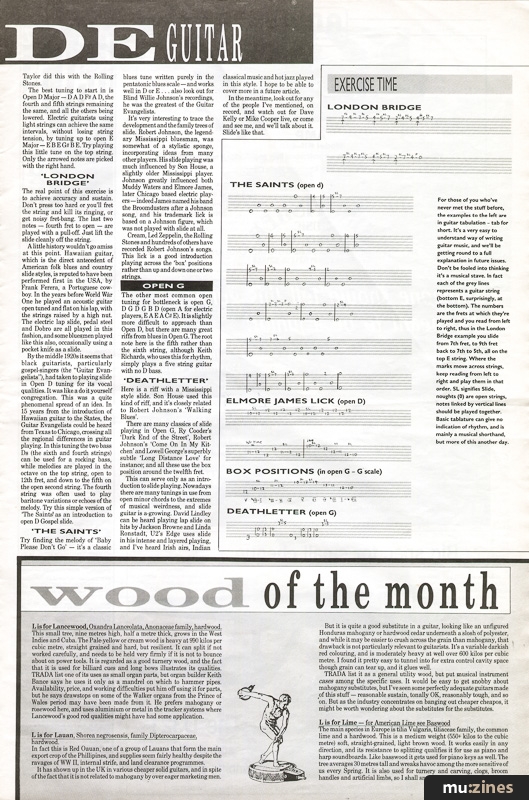Magazine Archive
Home -> Magazines -> Issues -> Articles in this issue -> View
Wood Of The Month | |
Article from Making Music, September 1987 | |
L is for Lancewood, Oxandra Lanceolata, Anonaceae family, hardwood.
This small tree, nine metres high, half a metre thick, grows in the West Indies and Cuba. The Pale-yellow or cream wood is heavy at 990 kilos per cubic metre, straight grained and hard, but resilient. It can split if not worked carefully, and needs to be held very firmly if it is not to bounce about on power tools. It is regarded as a good turnery wood, and the fact that it is used for billiard cues and long bows illustrates its qualities. TRADA list one of its uses as small organ parts, but organ builder Keith Bance says he uses it only as a mandrel on which to hammer pipes. Availability, price, and working difficulties put him off using it for parts, but he says drawstops on some of the Walker organs from the Prince of Wales period may have been made from it. He prefers mahogany or rosewood here, and uses aluminium or metal in the tracker systems where Lancewood's good rod qualities might have had some application.
L is for Lauan, Shorea negrosensis, family Dipterocarpaceae, hardwood.
In fact this is Red Oauan, one of a group of Lauans that form the main export crop of the Phillipines, and supplies seem fairly healthy despite the ravages of WWII, internal strife, and land clearance programmes.
It has shown up in the UK in various cheaper solid guitars, and in spite of the fact that it is not related to mahogany by over eager marketing men.
But it is quite a good substitute in a guitar, looking like an unfigured Honduras mahogany or hardwood cedar underneath a slosh of polyester, and while it may be easier to crush across the grain than mahogany, that drawback is not particularly relevant to guitarists. It's a variable darkish red colouring, and is moderately heavy at well over 600 kilos per cubic metre. I found it pretty easy to tunnel into for extra control cavity space though grain can tear up, and it glues well.
TRADA list it as a general utility wood, but put musical instrument cases among the specific uses. It would be easy to get snobby about mahogany substitutes, but I've seen some perfectly adequate guitars made of this stuff — reasonable sustain, tonally OK, reasonably tough, and so on. But as the industry concentrates on banging out cheaper cheapos, it might be worth wondering about the substitutes for the substitutes.
L is for Lime — for American Lime see Baswood
The main species in Europe is tilia Vulgaris, tiliaceae family, the common lime and a hardwood. This is a medium weight (550+ kilos to the cubic metre) soft, straight-grained, light brown wood. It works easily in any direction, and its resistance to splitting qualifies it for use as piano and harp soundboards. Like basswood it gets used for piano keys as well. The tree averages 30 metres tall and wreaks havoc among the more sensitive of us every Spring. It is also used for turnery and carving, clogs, broom handles and artificial limbs, so I shall sneeze on without complaint.
Publisher: Making Music - Track Record Publishing Ltd, Nexus Media Ltd.
The current copyright owner/s of this content may differ from the originally published copyright notice.
More details on copyright ownership...
Feature by Adrian Legg
Help Support The Things You Love
mu:zines is the result of thousands of hours of effort, and will require many thousands more going forward to reach our goals of getting all this content online.
If you value this resource, you can support this project - it really helps!
Donations for December 2025
Issues donated this month: 0
New issues that have been donated or scanned for us this month.
Funds donated this month: £0.00
All donations and support are gratefully appreciated - thank you.
Magazines Needed - Can You Help?
Do you have any of these magazine issues?
If so, and you can donate, lend or scan them to help complete our archive, please get in touch via the Contribute page - thanks!


